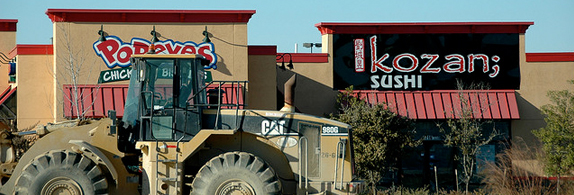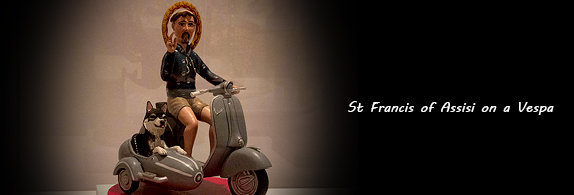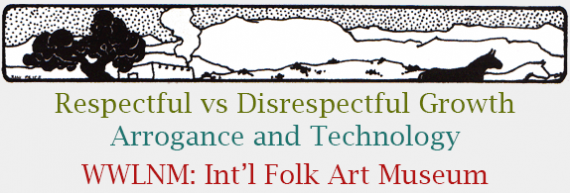Respectful vs. Disrespectful Growth

Boomers of all sorts equate growth, any kind of growth, with financial prosperity. Boomers are numbers people. The basic connection is that “more” is “better.” They are people who focus on quantity, not quality. The spectrum of boomerism runs from knowing the price of everything but the value of nothing, as the saying goes, to a conservatism that is penny wise but pound foolish. And yet boomers are supreme gamblers. In land speculation they wager vast sums of money, rarely their own, on future glories usually based on pie in the sky predictions of future population expansion which, since the 1990s, has stopped paying off as expected.
The kind of growth boomers champion is what I’ve come to call disrespectful growth—disrespectful to the property rights and values of existing residents, disrespectful of environmental health and disrespectful of local culture and the continuity of empowering tradition.
In Albuquerque, at the moment. I’d lump together the proposed gigantic Santolina sprawl development on the southwest mesa, the huge truck/rail loading center and temporary storage site being built in the Mountain View neighborhood, and the asphalt plant to be constructed across Second Street SW from the Valle del Oro Wildlife Refuge and put them all on the disrespectful growth side of the ledger. I’d put most of the strip malls and major thoroughfares west of the Rio Grande and in the far northeast heights in the same category.
Respectful growth is usually what’s on the agenda of local property owners, neighborhood associations, people concerned with water quality and quantity, as well as air, noise and light pollution, people who value continuity, who prefer to shop at local stores, who understand local history and culture, people who are not colonizers and exploiters but inhabitants. For them, context is everything. And respectful growth is about respecting context.
Respectful growth tends to be slow, deliberative, flavored with back and forth discussion and rich in productive compromise. Respectful growth ends up belonging where it is.
The historic zone in Old Town is a good example. The Museum of Albuquerque and the other museum structures in the area respect the architectural and historic context of the surrounding neighborhoods. So does the Sawmill residential complex nearby. The nearly invisible Rio Grande Nature Center blends in so totally with the surrounding riparian environment that the building itself becomes a kind of duck blind. Rio Grande Boulevard and Central, from the Atrisco river crossing to the end of Nob Hill, have also seen strong efforts to respect context.
Developers and planners often complain that neighborhoods see any kind of infill growth in their areas, or any change at all, as inherently disrespectful. Neighbors complain that new infill efforts almost invariably require zoning changes and zoning, for them, is seen as protection against change, not to be summarily tossed aside.
As water becomes ever more expensive and harder to come by and as sprawl becomes ever more costly for governments to support, growth advocates and the building industry will look to infill as one of the few remaining engines of economic gain. But the dynamics of negotiation will have to change or neighborhoods of existing residents will continue to resist most new growth in their area with everything they’ve got.
Contradictory perceptions of zoning and growth have defined the history of infill development in Albuquerque since the l970s. It’s always been a bitter struggle. Neighbors want respect. Developers tend to see neighbors as pests and obstructionists. And neighbors often look at developers as flashy vandals. Nasty conflicts are inevitable.
But in a water-starved future population, growth will be minimal and development will largely mean in-migration of existing residents seeking to move from expensive sprawling enclaves into other parts of the city with infrastructure and public transit already in place. This means, unhappily, many skirmishes and some outright wars between those who have differing views of respect and disrespect. Political and business careers will rise and fall on the outcomes.
What does respectful growth look like in the arid and economically troubled future of Albuquerque and the American West? Respectful growth will be judged as development that costs the taxpayer and existing residents little to nothing in actual money and even less in physical, psychological, and aesthetic disruption. People who stand to make money from development will have to foot all their own bills. And everyone, residents and developers and planners,will have to become increasingly artful mediators of seemingly intractable conflicts.
If cities can’t afford sprawl growth and taxpayers judge it disrespectful of their plight and situation, then infill is the wave of the future. But if mediation doesn’t work between stubborn parties, I can see a future in which government and politicians representing business interests actually force infill on neighborhoods, like it or not.
Disrespectful growth will always be opposed, tooth and nail, whether it’s a matter of perception or not. Disrespectful opposition to growth will always be fought tooth and nail, whether it’s a matter of perception or not. Conflict is expensive. Only mature and creative compromises can make situations better. And only in a context of respect is it possible for fruitful collaboration to morph out of struggle and deadlock.
Arrogance and Technology

When parts of the salt ceiling at the Waste Isolation Pilot Project (WIPP), nearly a half a mile underground, started caving in a couple of weeks ago I thought of all the promises, assurances and absolute pronouncements about the facility over the years that left citizens with the feeling that everything there was infallibly safe and that the technology was flawless. Only paranoids and cranks could possibly think that anything could go wrong.
The ceiling collapse might prove to be a minor moment in the deep salt repository’s contemporary history. But the explosion of a barrel of nuclear waste on Valentine’s Day last year was a major moment. It sent nuclear contamination into the atmosphere around Carlsbad and in the process contaminated some 8,000 feet, or more than a mile and a half, of underground salt corridors, making the place so dangerous WIPP workers have to wear gear that resembles what Ebola workers had to wear. And now we know that it’s not just one barrel that’s dangerous but as many as 700 or more. Some are inside the WIPP site and some in other facilities. There’s already 70,000 barrels of “low-level” radioactive waste in WIPP right now. You can learn more about WIPP by visiting the website of The Southwest Research and Information Center.
WIPP makes a powerful point about technology. Don’t believe any bureaucrat, any technocrat, any politician, or any engineer who is so confident of the perfection of their expertise that they brush aside any questions as if they were mere folly rooted in ignorance and silly worries.
The point is that things always go wrong. And it’s usually the plumbing or the welds, or the all but inevitable appearance of human error. If there’s ever a certainty in this life it is that nothing works perfectly all the time. This proves out so consistently one might consider it a law of human nature. Failure is just around the corner. Have a backup, or better yet ten back ups. Imagine if you trusted the invisible hand of the stock market and had all your life savings invested there with no backup of funds in banks and credit unions or gold or other securities. The market falls, as it always will, and you’re left helpless to ride it out with little or nothing because you had no backup strategy in place.
I’m reminded of the near catastrophe in North Carolina in l961 when a B-52 bomber lost a wing and plunged to the ground outside the city of Goldsboro, loaded with two hydrogen bombs hundreds of times stronger than the bomb that flattened Hiroshima. This was one of 32 such incidents that the Department of Defense owns up to from l950 to l980. Both bombs that landed near Goldsboro were unarmed, or unfused, but just barely. Neither one exploded. One had been disarmed by an alert crew member as the plane was breaking in half. The other bomb didn’t go off because of a flaw in the arming mechanism.
Thank heavens for flaws—in this case.
WIPP was sold to the world, and to skeptical New Mexicans, as without flaw, as being safe for 10,000 years and beyond, as something we could bet the farm on. Human error, incompetence, fatigue, and bureaucratic entanglements were never taken into consideration. The metaphor of entropy, the inevitable descent into disorder and accident, was apparently never considered by physicists, engineers, and their bosses when designing WIPP. They believed their own storyline, so they had no backup plans.
Backup is everything. But backup seems to be hit or miss at the metro area’s sewage treatment plant, and at the one in Rio Rancho, which dumps untreated sewage into the Rio Grande far too often. The big treatment plant on South Second, that cleans up the waste of the entire city of Albuquerque, suffered one of PNM’s frequent power outages two weeks ago and dumped six hours worth of partially treated sewage into the Rio Grande. It seems the backup system wouldn’t turn on.
It’s sort of like what happened with the Kirtland jet fuel spill. A failure in equipment, a joint or a weld or a seal, leaked fuel into the ground for some 50 years without being detected. The loss of more than 24 million gallons of jet fuel never raised a bleep on the Department of Defense's inventory checks and audits. I’m not sure if that’s just incompetence or if it’s negligence. But we all know who’s going to pay for it.
Let’s let realism prevail. Nothing is fail-safe. Maintenance is mandatory.
Backups are never not prudent. Spend some money up front for precautionary systems rather than a ton of money for accidents. And, please, don’t re-open WIPP without strategies and systems in place to prevent or contain the next failure that’s sure to come.
Why We Love New Mexico: International Folk Art Museum

In less than an hour’s drive from Albuquerque resides the largest collection of folk art in the world. It’s housed in the Museum of International Folk Art on Museum Hill in Santa Fe. And it’s definitely not just for tourists. Nor are the dozens of other wonderful museums, big or small, in our state. They are for all of us, gifts of the curiosity and caring of thousands of people over the decades who know that life is worth savoring in all its fascinations, and that the past is to be preserved if we are not to fall into a state of disorientation and cultural amnesia.
The Folk Art Museum reveals the font of human imagination like few places can. It’s not just the talent and gifts of great and famous artists that embellish the human world and define its yearnings and its delights. The Folk Art Museum shows us that virtually everyone has something to say and express, and that one of the greatest menageries of the imagination is to be found in the world of toys.
The over 130,000 objects in the Folk Art Museum come from more than a 100 counties. It’s like walking into a mythological space filled floor to ceiling with the energy, enjoyment, and whimsy of pure fun embodied in the play of adults delighting children, or adults paying homage, in their own ways, to their sense of the divine.
Enormous, colorful miniature townscapes with a many hundreds of vendors, dancers, marching bands and other musicians, cooks, cars, trees and houses fill the spaces. Trains and processions and trees of life, and beaded Madonnas, and nativities, and dolls and doll houses—all of them coming together in a fantastic, almost operatic profusion of eye dazzling talent creating temptations of curiosity that are satisfied again and again.
I’d forgotten one can visit such a place any time one wants. It’s not just for the idle tourist. One could spend days and months over the years in the Museum of International Folk Art and be fortified in one’s belief that the human species is ultimately creative and resourceful, and leave each time full of hope and full of admiration for our own kind. It seems the whole world can nurture such creativity and that’s a great feeling.
(Photos: Sprawl growth by Rich Anderson / CC; screen data by r2hox / CC; St. Francis on a Vespa by Steven Depolo / CC)




Responses to “Provincial Matters, 3-30-2015”